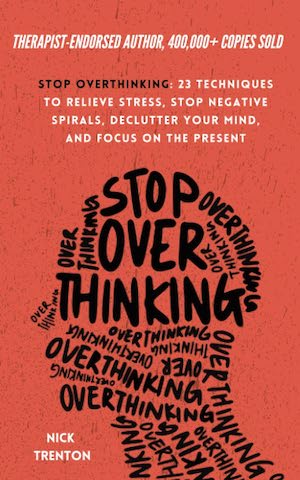Stop Overthinking:不安感を「ロジカルに解消する為」のノウハウ本

不安感が高まりやすいので読みました。過去にこういった本は色々と読んだのですが、最も「ロジカルな内容」でした。
引用しつつ、不安解消のテクニックを4つ掲載します。
※英文の後に、AIを使った自動翻訳を載せておきます。自動化しているので、すこし読みづらいかもです。ご了承ください。
不安の消し方① : 不安を書き起こす
Stress Diaries and Journals. Another concrete way to bring more awareness to your daily experience of stress is to write it all down. With overthinking, it can sometimes seem like there are a million things on your plate a once, and it's hard to decide what single cause is really behind your anxiety.
In 2018, researchers Smythe et. al. at PennsvIvania State University found that positive affect journaling (PAJ) was positively correlated with better emotional self-regulation, improved wellbeing, and fewer depression and anxiety symptoms one month after starting an online journaling program.
To do this kind of journaling, simply write about a traumatic experience for no more than fifteen to twenty minutes for around three to five days. As you write, gradually shift your focus onto positive aftects, ie, good emotions. You can use prompt like: What has someone done to help you? What are you grateful for? What are your ultimate values and principles?
ストレスの日記とノート。毎日のストレスをもっと理解するための具体的な方法は、それを全部書き留めることです。考えすぎると、いっぱいのことが同時に起こっているように感じ、どのことが本当の心配の原因か決めるのが難しいことがあります。
2018年に、ペンシルベニア州立大学のSmythe先生たちの研究で、ポジティブな気持ちの日記(PAJ)を書くことが、感情の自己管理、よい気分、そしてオンラインの日記プログラムを開始してから1ヶ月後のうつ症状や不安症状の減少と関連があることがわかりました。
このような日記を書くには、トラウマ体験について15〜20分の間で3〜5日書きます。書くうちに、良い感情、つまり、ポジティブな気持ちに焦点を当てるように変えていきます。次のような質問を使って考えることができます:誰かがあなたを助けるために何をしてくれましたか?何に感謝していますか?あなたの大切な価値観や原則は何ですか?
不安の消し方② : リラックスに集中する
1. Find a comfortable position, sitting or lying down, take some slow deep breaths, and begin by slowly repeating to yourself six times, "I am completely calm." If you are doing the second "lesson," for example, you can focus on warmth. Put your awareness onto sensations of warmth in your body.
2. Then repeat, also six times, "My left arm is warm," followed by six repetitions of, "I am completely calm." Say this slowly and really engage with the sensations, slowing your breath and focusing only on your body.
3. Follow up with your other arm, both legs, chest, and abdomen, alternating with, "I am completely calm.”
4. Reverse the process by saying, "Arms, firm up," "I am alert," and so on and finally, “Eyes open," as you end the session. It should take fifteen to twenty minutes in total.
1. 快適な姿勢で座ったり横になったりして、ゆっくりと深呼吸を取り、始めに「私は完全に落ち着いている」と自分に6回繰り返して言ってください。2番目の「レッスン」を行っている場合は、温かさに焦点を当てることができます。体の温かさを感じることに意識を向けてください。
2. 次に、「私の左腕は暖かい」とも6回繰り返し、「私は完全に落ち着いている」とも6回繰り返してください。ゆっくりとこれを言いながら、その感覚に真剣に向き合い、息をゆっくりとして体だけに焦点を当ててください。
3. もう一方の腕、両足、胸、お腹と続けて、「私は完全に落ち着いている」と交互に言ってください。
4. 最後に、逆の手順で、「腕、しっかりと」「私は目を覚ましている」などと言って、「目を開けて」と言いながらセッションを終了します。これには合計で15〜20分かかります。
不安の消し方③ : 不安の延期 or 時間制限
You don't need to completely vanquish worry -but simply make an agreement with yourself to not do it right away. Their research focused on people's tendency to report "subjective health complaints," but the idea can be applied to many other measures of anxiety and rumination. According to their findings, worry postponement is an effective way to put objective distance between a person and their distressing thoughts.
The first is that if you delay the worry, you often don't want to do it later anyway. The second is that even when you do permit yourself some worry time, you'll often notice that your anxiety levels are exactly the same before the worry and after. Meaning, the worry time did precisely zero to help. In either case, you are limiting and managing the effect that worry has on you and teaching yourself that you have a choice and are not at the mercy of distracting, intrusive thoughts.
心配を完全に消す必要はありません。ただ、すぐにそれをしないと自分自身と約束するだけです。彼らの研究は、人々が「主観的な健康の不調」を報告する傾向に焦点を当てていますが、この考え方は不安や考えすぎの他の指標にも適用できます。彼らの結果によれば、心配を先延ばしにすることは、人とその悩ましい考えとの間に客観的な距離を置く効果的な方法です。
一つ目のポイントは、心配を遅らせると、後でそれをしたくないことが多いことです。二つ目は、心配する時間を許しても、心配する前と後での不安のレベルが全く同じであることをしばしば気付くことです。つまり、心配する時間は全く役に立たないということです。どちらの場合でも、心配があなたに与える影響を制限・管理しており、選択の自由があり、邪魔な考えに翻弄されているわけではないことを自分自身に教えています。
不安の消し方④ : 改善サイクルを組む
1. Clarify the belief. State clearly what your thought is and write it down, as well as the associated emotion and its intensity. In this example, "Everyone hates me."
2. Create a hypothesis, which contains a potential alternative, ie., "some people don't hate me."
3. Create an experiment to test this hypothesis. What would you need to do to genuinely put this belief to the test? Perhaps you could look for instances in the past in which people have told you they liked you, or you could observe the behavior of those around you in a period of a week to see how they behave to you and see whether this is compatible with an attitude of "hate."
4. Run the experiment as open-mindedly as you can and write down your observations. Perhaps you notice that many people deliberately reach out to you during the week to ask to spend time with you, and go out of their way to be around you.
5. Analyze these results. What conclusion can you make? Does the original belief of "everyone hates me" stand up to scrutiny? Notice, also, the change in feeling you have when you change the belief.
6. Make adjustments to this belief, and when you're unsure, come back to your experiment and remind yourself that you have logically and practically proven to yourself otherwise. Remember the feelings associated with the alternative belief.
1. 信じていることを明確にしてください。あなたの考えをはっきりと述べ、それを書き留め、それに関連する感情とその強さも書きます。この例では、「みんな私のことが嫌いだ。」
2. 仮説を立てます。代替案を含むもの、つまり、「みんなが私のことを嫌っているわけではない」というようなものです。
3. この仮説を試すための実験を考えます。この信念を本当に試すためには、どうすればいいでしょうか?過去に人々があなたのことを好きだと言った時を探してみたり、1週間の間に周りの人々の行動を観察して、それが「嫌い」という態度と合致しているかどうかを確かめることができます。
4. 出来るだけ公平に実験を行い、観察結果を書き留めます。たとえば、多くの人が1週間の間にわざわざあなたに会いたいと言ってきたり、あなたの周りにいるために努力していることに気づくかもしれません。
5. これらの結果を分析します。どのような結論を得られますか?「みんな私のことが嫌いだ」という元の信念は検証に耐えることができるでしょうか?信念を変えるときに感じる気持ちの変化にも注意してください。
6. この信念に修正を加え、不安に感じるときは、あなたの実験に戻って、論理的に、実際に自分自身に証明したことを思い出してください。代わりの信念に関連する感情を覚えておいてください。
さらに思考やマインド面で参考になった部分は下記。
問題があるなら行動したらいい。不安だけを感じても意味ない
But what if it is a serious problem and you can act right now? Then act. Worry and overthinking are useless, particularly when appropriate action is what's called for.
でも、本当に深刻な問題があって、今すぐ行動できるとしたら?その時は行動してください。特に適切な行動が求められる時には、心配や考えすぎは役に立たない。
考え過ぎの人は、自分が問題解決していると勘違いしている。実際には何も解決していない。
We might become habitual overthinkers because it makes us feel like we're somehow tackling the problem we're overthinking about. Because the overthinking never ends, this doesn't happen, but we still feel like we're making some progress. This turns into a vicious cycle that can be hard to escape.
考えすぎることが習慣になるかもしれません。それは私たちが何か問題に取り組んでいるように感じさせるからです。考えすぎが終わらないので、問題は解決されませんが、進歩しているように感じます。これは悪いサイクルとなり、抜け出すのが難しくなります。
休憩やリラックスは重要である。このマインドセットを持つ。
One mindset shift is to see rest and relaxation as important and worthy of your focus, and not just something you tack onto the end of a day once more important things are done. One way to do this is to schedule in time for fun and enjoyable activities, or simply time when you're not doing anything at all.
気持ちの切り替えとして、休息やリラックスは重要で、注目に値するものとして見ることができます。大切なことをすべて終わらせてからの余分な時間としてではありません。これを実現する方法の一つは、楽しい活動の時間をスケジュールに入れること、または何もしない時間を作ることです。
ストレスが低すぎてもストレスを感じる
We can also be stressed by the complete lack of stimulation. Known as hypo-stress, this form of stress occurs when we aren't being challenged enough by our environment.
私たちが何も刺激を受けていない時もストレスを感じることがあります。これは「ハイポストレス」として知られていて、私たちの環境に十分に挑戦されていない時に起こるストレスの形です。
コントロール出来ない領域にフォーカスすればするほど、自分のコントロールを失う
Epictetus saying, "Just keep in mind: the more we value things outside our control, the less control we have."
» Stop Overthinking: 23 Techniques to Relieve Stress, Stop Negative Spirals, Declutter Your Mind, and Focus on the Presentエピクテトスの言葉、「覚えておきなさい:コントロール出来ない領域にフォーカスすればするほど、自分のコントロールを失う」
